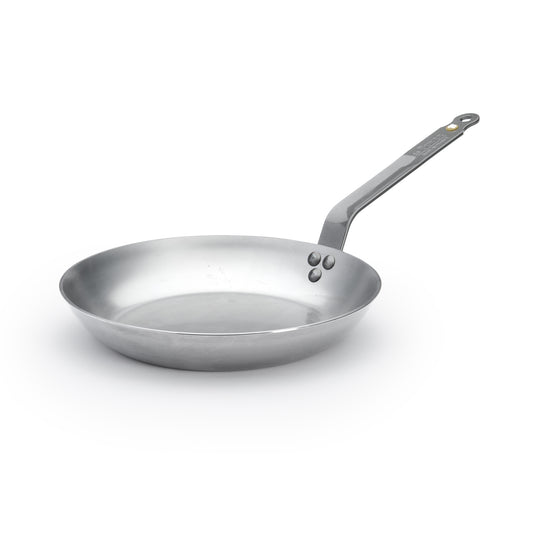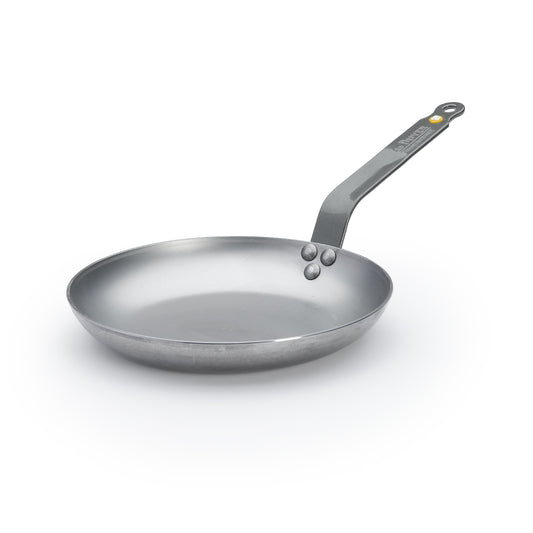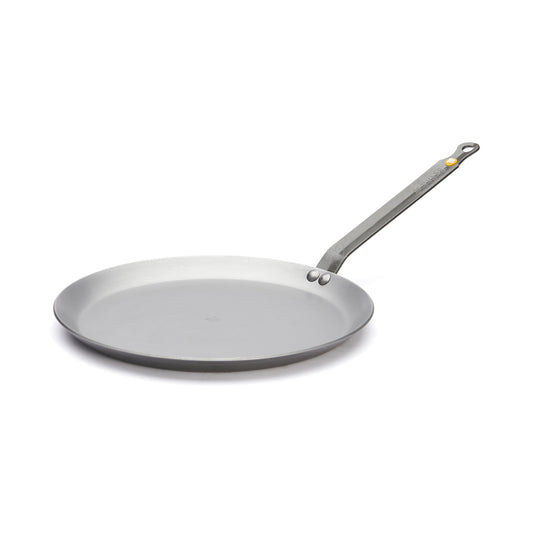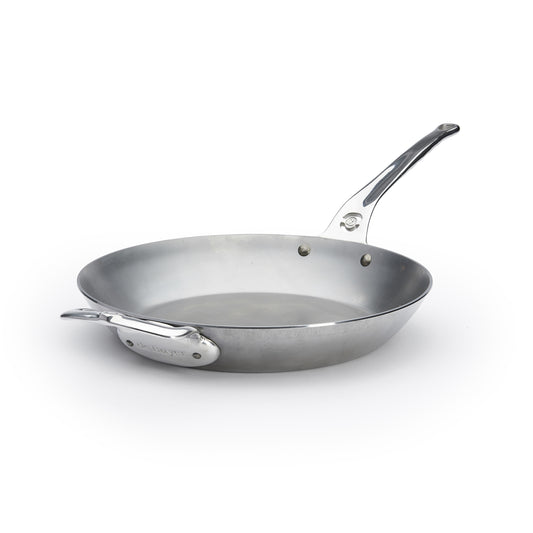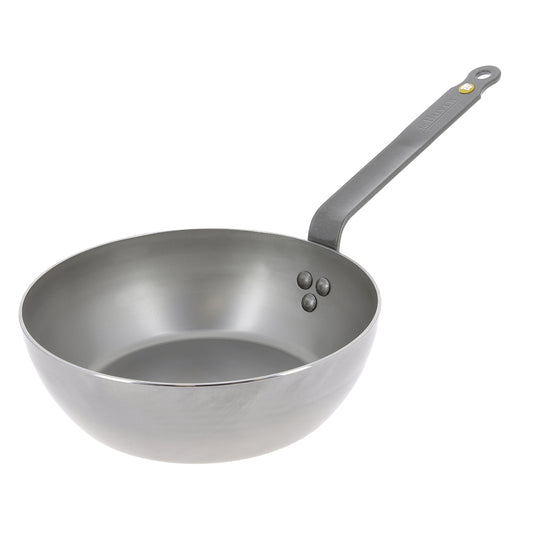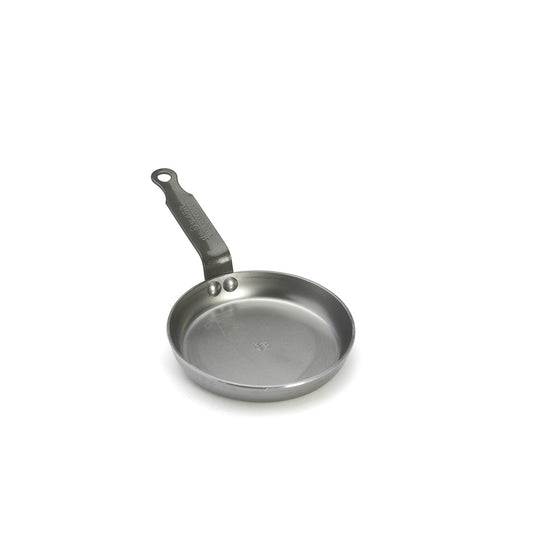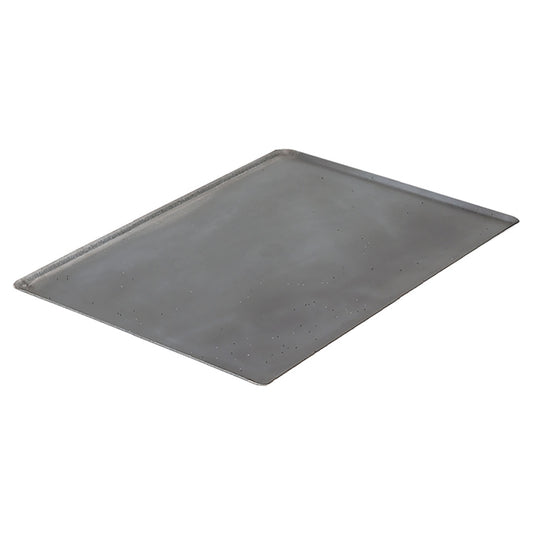How to Organize Pots and Pans: Expert Tips for Longevity and Easy Access
Learn how to organize pots and pans with expert tips to maximize space, protect your cookware, and keep your kitchen running smoothly.
de Buyer

Keeping a kitchen's worth of pots and pans organized is challenging. You must balance the need for accessibility and the cookware's maintenance requirements. Proper storage keeps things organized and prevents scratches, dents, and other wear and tear, helping your cookware last longer.
This article will provide practical tips for organizing pots and pans in a way that optimizes your space, reduces damage, and makes cooking more efficient.
Why Proper Organization is Important
Typically, the more you fall in love with cooking and baking, the more pots and pans you accumulate. As home cooks and professional chefs refine their abilities and expand their repertoire, it's normal to add on cookware of different materials and cookware for specialty cuisine.
Continuing to purchase more cookware without a proper organizational system in place can actually damage your pots and pans. When these metals are continuously stacked on or pressed against each other, the likelihood of scratches and scuffs increases.
Buying durable cookware will prevent most scratches, but even a carbon steel pan can scratch another pan made of carbon steel, not to mention the risk that harder metals pose to non-stick-coated pans and pots.
It can also get confusing when your cookware constantly moves around the kitchen, making it difficult to find things in a moment of need. You may find yourself spending more and more time hunting for the right cookware piece and less time actually cooking. In a home kitchen, this is frustrating. In a professional kitchen, this is detrimental.
An organized kitchen will improve efficiency and extend the life of high-quality cookware.
Best Practices for Organizing Pots and Pans
If you live in an apartment or work in a tight professional kitchen, you'll have to get pretty creative with your storage solutions. These are the top methods for organizing pots and pans to help you design a functional space. These options maximize space and prevent damage. Regardless of your chosen method, the absolute best tip is that every pot, pan, and cooking utensil must have an assigned seat.
When you're considering which organizational style works best for your kitchen, think about how much cookware you have, available storage space, and where you would prefer each piece to permanently live.
Use Pan Organizer Racks
Pan organizers, pot racks, or drawer dividers keep cookware separated and prevent scratching. These organizers come in all different shapes and sizes and can even be custom-made to fit your kitchen cabinets or pantry. If you're not interested in spending a ton of money on an organizer, then any local store should have mini plastic shelves that fit your space.
Stack Pots and Pans Carefully
If you have limited cabinet space and stacking is necessary, place a soft towel or felt pan protector between each item to avoid direct contact. This method requires stacking and unstacking pans as you need them, but it is a space saver. Always stack the largest pans at the bottom, getting progressively smaller as you continue to stack.
Hang Pots and Pans for Easy Access
Maximize your kitchen’s vertical space by hanging pots and pans on hooks or a wall-mounted rack. This frees up cabinet space and makes items easily accessible. Alternatively, you may utilize any wall space by installing a peg board and hanging cookware from there.
Consult a contractor or structural engineer before installing any sort of hanging system. You'll likely need to securely attach your rack or pegboard to a load-bearing post or joist.
Store Lids Separately
Storing pots with their lids is impossible using the hanging or stacking methods. Use lid organizers or racks for easy access to pot lids while keeping them from getting scratched or damaged.
Consider Drawer Storage for Smaller Pans
If space is limited, use deep drawers with dividers for storing smaller pans, keeping them organized and accessible without the need to stack. Use non-slip liners to prevent pans from shifting when opening and closing the drawer.
Tips for Organizing Based on Cookware Material
You don’t have to separate all pans by material, but you should pay attention to the unique maintenance requirements of each pan type and store accordingly.
Carbon Steel and Cast Iron Pans
Carbon steel and cast iron pans should be stored carefully to preserve their seasoning, the protective patina that forms on the pan over time. Store pans on an extra-sturdy hanging rack since these are commonly the heaviest pots in any kitchen.
Stacking is still an option, but since these pans are heavier, it can be frustrating to stack and unstack them constantly.
Nonstick Pans
Nonstick pans should be stored with care to avoid scratching the coating. Keep these pans separate from pans of more durable construction if possible. Use dividers or hang them in a way that minimizes damage.
Once you've scratched the nonstick coating, you have to toss the entire pan. Technically, the pan will still work and provide a decent level of nonstick cooking. But the coating may start to flake off into your food, and slowly, over time, the pan will cease to function as nonstick.
Stainless Steel Pans
Stainless steel cookware is known for even heat distribution and resistance to rust and corrosion. This durable cookware can still benefit from being stored in a way that avoids denting. Hanging is, of course, an option, but you can also use cabinet dividers to keep each pan separated or place them flat in a cabinet.
Common Mistakes to Avoid When Organizing Pots and Pans
These are the common mistakes people make when organizing cookware and how to avoid them:
-
Overcrowding: Avoid overloading cabinets or drawers, as this can lead to pans being stacked too tightly and causing scratches or warping.
-
Improper Handling: Don’t pull cookware by the handle or lid if it's stacked or stuck—this can cause damage. It can take time to adjust to your new storage solution. If your pan becomes wedged somewhere or is at the bottom of a stack, carefully remove it without yanking it by the handle.
-
Storing Pans in Damp Conditions: Moisture can lead to rust, particularly with cast iron and carbon steel pans. Don't store your pans in any part of your kitchen that is regularly exposed to moisture. This means avoiding storing around the sink.
-
Hanging Too Low: If you're not used to hanging pot organization, then it can be tough to figure out the best height. Too high will be challenging for shorter people to reach, and too short will block kitchen sight lines. Ultimately, your storage solution should keep your pots safe and functional for regular kitchen activities.
Organize and Protect Your Cookware with de Buyer
Proper storage prevents damage, preserves performance, and makes it easier to access the cookware when you need it. Select the best storage solution for your space and preferences.
With de Buyer’s premium cookware, investing in high-quality materials is simple. When properly cared for and stored, your de Buyer pots and pans will last decades. Keep your carbon steel, stainless steel, and copper essentials well-organized to protect their structural integrity and ensure they perform at their best.
Explore de Buyer’s full range of professional-grade cookware sets and discover why choosing durable, well-crafted pieces is worth the effort of proper organization.
Learn More
Recommended for You
-
MINERAL B PRO Carbon Steel Fry Pan
Regular price $90.00Regular priceUnit price / per$0.00Sale price $90.00 -
MINERAL B Classic Carbon Steel Fry Pan
Regular price $60.00Regular priceUnit price / per -
MINERAL B Carbon Steel Omelette Pan
Regular price $65.00Regular priceUnit price / per -
MINERAL B PRO Carbon Steel Omelette Pan
Regular price $105.00Regular priceUnit price / per -
Protective Sleeve for Pan Handle
Regular price $9.95Regular priceUnit price / per -
MINERAL B Carbon Steel Crepe & Tortilla Pan
Regular price $70.00Regular priceUnit price / per -
MINERAL B PRO Carbon Steel Fry Pan with Helper Handle
Regular price $145.00Regular priceUnit price / per -
 Sold out
Sold outBlue Carbon Steel Fry Pan
Regular price $45.00Regular priceUnit price / per -
Blue Carbon Steel Crepe & Tortilla Pan
Regular price $25.00Regular priceUnit price / per -
MINERAL B Carbon Steel Country Fry Pan
Regular price $100.00Regular priceUnit price / per -
MINERAL B Carbon Steel Egg & Pancake Pan
Regular price $35.00Regular priceUnit price / per -
Blue Carbon Steel Rectangular Baking Sheet
Regular price $35.00Regular priceUnit price / per












